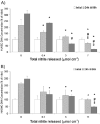Poly(diol-co-citrate)s as novel elastomeric perivascular wraps for the reduction of neointimal hyperplasia
- PMID: 21341372
- PMCID: PMC4068126
- DOI: 10.1002/mabi.201000509
Poly(diol-co-citrate)s as novel elastomeric perivascular wraps for the reduction of neointimal hyperplasia
Abstract
The synthesis of poly(diol-co-citrate) elastomers that are biocompatible with vascular cells and can modulate the kinetics of the NO release based on the diol of selection is reported. NO-mediated cytostatic or cytotoxic effects can be controlled depending on the NO dose and the exposure time. When implanted in vivo in a rat carotid artery injury model, these materials demonstrate a significant reduction of neointimal hyperplasia. This is the first report of a NO-releasing polymer fabricated in the form of an elastomeric perivascular wrap for the treatment of neointimal hyperplasia. These elastomers also show promise for other cardiovascular pathologies where NO-based therapies could be beneficial.
Copyright © 2011 WILEY-VCH Verlag GmbH & Co. KGaA, Weinheim.
Figures









Similar articles
-
Nitric oxide and nanotechnology: a novel approach to inhibit neointimal hyperplasia.J Vasc Surg. 2008 Jan;47(1):173-82. doi: 10.1016/j.jvs.2007.09.005. J Vasc Surg. 2008. PMID: 18178471 Free PMC article.
-
Periadventitial atRA citrate-based polyester membranes reduce neointimal hyperplasia and restenosis after carotid injury in rats.Am J Physiol Heart Circ Physiol. 2014 Nov 15;307(10):H1419-29. doi: 10.1152/ajpheart.00914.2013. Epub 2014 Sep 19. Am J Physiol Heart Circ Physiol. 2014. PMID: 25239800 Free PMC article.
-
Effect of nitric oxide on neointimal hyperplasia based on sex and hormone status.Free Radic Biol Med. 2011 May 1;50(9):1065-74. doi: 10.1016/j.freeradbiomed.2011.01.016. Epub 2011 Jan 21. Free Radic Biol Med. 2011. PMID: 21256959 Free PMC article.
-
A rapamycin-releasing perivascular polymeric sheath produces highly effective inhibition of intimal hyperplasia.J Control Release. 2014 Oct 10;191:47-53. doi: 10.1016/j.jconrel.2014.05.017. Epub 2014 May 20. J Control Release. 2014. PMID: 24852098 Free PMC article.
-
Ginsenoside Re inhibits vascular neointimal hyperplasia in balloon-injured carotid arteries through activating the eNOS/NO/cGMP pathway in rats.Biomed Pharmacother. 2018 Oct;106:1091-1097. doi: 10.1016/j.biopha.2018.07.044. Epub 2018 Jul 17. Biomed Pharmacother. 2018. PMID: 30119175
Cited by
-
Delivery of Antioxidant and Anti-inflammatory Agents for Tissue Engineered Vascular Grafts.Front Pharmacol. 2017 Sep 21;8:659. doi: 10.3389/fphar.2017.00659. eCollection 2017. Front Pharmacol. 2017. PMID: 29033836 Free PMC article. Review.
-
Polymer-Based Nitric Oxide Therapies: Recent Insights for Biomedical Applications.Adv Funct Mater. 2012 Jan 25;22(2):239-260. doi: 10.1002/adfm.201101707. Adv Funct Mater. 2012. PMID: 25067935 Free PMC article.
-
Citrate-Based Biomaterials and Their Applications in Regenerative Engineering.Annu Rev Mater Res. 2015 Jul;45:277-310. doi: 10.1146/annurev-matsci-070214-020815. Epub 2015 Mar 23. Annu Rev Mater Res. 2015. PMID: 27004046 Free PMC article.
-
Engineering multifunctional bioactive citrate-based biomaterials for tissue engineering.Bioact Mater. 2022 May 7;19:511-537. doi: 10.1016/j.bioactmat.2022.04.027. eCollection 2023 Jan. Bioact Mater. 2022. PMID: 35600971 Free PMC article. Review.
-
In-Stent Restenosis and a Drug-Coated Balloon: Insights from a Clinical Therapeutic Strategy on Coronary Artery Diseases.Cardiol Res Pract. 2020 Oct 25;2020:8104939. doi: 10.1155/2020/8104939. eCollection 2020. Cardiol Res Pract. 2020. PMID: 33163230 Free PMC article. Review.
References
-
- Palmer RM, Ferrige AG, Moncada S. Nature. 1987;327:524. - PubMed
-
- Ignarro LJ, Byrns RE, Buga GM, Wood KS. Circ Res. 1987;61:866. - PubMed
-
- Lundberg JO, Weitzberg E, Gladwin MT. Nat Rev Drug Discov. 2008;7:156. - PubMed
-
- Napoli C, Ignarro LJ. Arch Pharm Res. 2009;32:1103. - PubMed
-
- Frost MC, Reynolds MM, Meyerhoff ME. Biomaterials. 2005;26:1685. - PubMed
Publication types
MeSH terms
Substances
Grants and funding
LinkOut - more resources
Full Text Sources

